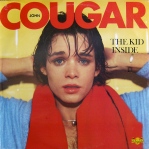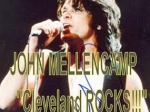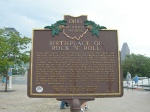
Backstage at the Agora following John Mellencamp's Coffee Break Concert. L to R: Matt the Cat, John Gorman, Jim Marchyshyn, Kid Leo, John Mellencamp, Dia Stein
It started with a dinner, months earlier, either sometime 1983 or early 1984 at a restaurant in the Marriott Airport hotel on W 130th, where John Mellencamp was staying. It could have coincided with a tour date or a promotional appearance.
John Mellencamp, a few of us from the station (Can’t remember who was there. My guess is Kid Leo and Jim Marchyshyn for starters), a label rep and either his manager or road manager, were discussing artists with songs that sound equally good when performed acoustic or electric. That conversation led to a discussion about the history of our Coffee Break Concerts – and how they started as acoustic studio affairs and evolved into a weekly afternoon live performance. Somewhere in that conversation a pitch was made to John and his band to do a Coffee Break Concert show and broadcast.
It was a long shot. John had been performing for a decade. He started out playing clubs in Indiana over a decade earlier and was now able to sell out major venues, including the Richfield Coliseum.
 We played John’s first album, Chestnut Street Incident in 1976, which was released under the name “Johnny Cougar” – against his better judgement by his mangaer, Tony DeFries, who was best known as David Bowie’s manager during his Ziggy Stardust period. Though we gave it a fair shot, it didn’t catch on with our listeners. It was also around that time that music director Shelley Stile went to Bloomfield, Ind. to see John in concert. We also played his second album, The Kid Inside, in 1977, but that album failed to ignite as well.
We played John’s first album, Chestnut Street Incident in 1976, which was released under the name “Johnny Cougar” – against his better judgement by his mangaer, Tony DeFries, who was best known as David Bowie’s manager during his Ziggy Stardust period. Though we gave it a fair shot, it didn’t catch on with our listeners. It was also around that time that music director Shelley Stile went to Bloomfield, Ind. to see John in concert. We also played his second album, The Kid Inside, in 1977, but that album failed to ignite as well.
In early 1978, his third album (as “Johnny Cougar”), A Biography was not released in the U.S. Someone sent us an import copy, and we played the track “I Need A Lover” a few times – but it was up against some stiff domestic-release competition that year – and our listeners were anticipating the long-awaited, long-delayed (due to legal issues) release of Bruce Springsteen’s Born to Run follow-up album, Darkness at the Edge of Town.
1978 was also our tenth anniversary, which was packed with concerts and special events – and it was also a year filled with superstar album releases – and break-out artists like Meatloaf, Eddie Money, The Cars, Dire Straits, Van Halen, and Bob Welch as a solo artist.
But in 1979, MCA records released the self-titled John Cougar album, which included the “I Need A Lover” track from the import. We started playing it again and this time it took off becoming one of our most-requested tracks – though it was the only track on the album to catch on.
The following year, John released It Doesn’t Matter and What if it Did – and the tracks “Ain’t Even Done with the Night” and “This Time” became top-requested tracks.
 In 1982, when American Fool was released, Cougar went straight to number one on the strength of two tracks – “Hurt So Good” and “Jack and Diane.” It also helped that their radio airplay was augmented by their music videos picking up heavy spins on a new cable channel called MTV. A few weeks after hitting number one in Cleveland sales – it did the same nationally.
In 1982, when American Fool was released, Cougar went straight to number one on the strength of two tracks – “Hurt So Good” and “Jack and Diane.” It also helped that their radio airplay was augmented by their music videos picking up heavy spins on a new cable channel called MTV. A few weeks after hitting number one in Cleveland sales – it did the same nationally.
In late 1983, when Uh-Huh was released, John went from being an established artist to superstar. That was also the year he added his real surname, Mellencamp.
It took a few months of heavy lobbying – but John finally agreed to do a Coffee Break Concert – but instead of doing it will a full band – he asked to do it as an acoustic performance – a throwback to the original version of the show. We agreed to a one-time only broadcast, which was stipulated in the contract – nor were we to play any excerpted songs from the performance, which we often did with our other live broadcasts.
The opportunity of having John Cougar Mellencamp do a special Coffee Break Concert was a major coup for us. He was now one of the biggest names in rock and roll. For crowd control purposes, we gave away tickets for his Coffee Break Concert in advance of the show.
 John took the stage at the Agora at 1 PM on Wednesday, August 25th and performed a 20-song acoustic set, which included a number of cover tunes, including the Beach Boys’ “Little Honda,” Bob Dylan’s “All Along the Watchtower,” Janis Joplin’s “Mercedes Benz,” John Prine’s “Sam Stone,” the Vogues’ “Five O’Clock World,” the Stones’ “Street Fighting Man,” and Elliot Murphy’s “Last of the Rock Stars.”
John took the stage at the Agora at 1 PM on Wednesday, August 25th and performed a 20-song acoustic set, which included a number of cover tunes, including the Beach Boys’ “Little Honda,” Bob Dylan’s “All Along the Watchtower,” Janis Joplin’s “Mercedes Benz,” John Prine’s “Sam Stone,” the Vogues’ “Five O’Clock World,” the Stones’ “Street Fighting Man,” and Elliot Murphy’s “Last of the Rock Stars.”
The show was one of our finest and proudest moments.
The concert broadcast has turned up on occasion at various Bit Torrent and bootleg trading sites. There are also a couple of bootleg CDs of the show. One can only hope that this concert sees a legitimate release in the near future.
Photo courtesy of Jim Marchyshyn. A few interesting notes about this photo. When it was first shown, the question was whose clothes were worse? My shirt or Leo’s pants. Related to that, a few months earlier I had kicked up my 3-½ packs a day cigarette habit – and gained a ton of weight. Today, John Mellencamp’s 14-year-old son has a Facebook group campaign to help his father kick the habit. He says, “I made a deal with my dad that if I get 1,000,000 to join this group he will quit smoking.” If you’re a Facebook user – find his page, sign up, and help John Mellencamp ditch the smokes.
No video was made of John Mellencamp’s Coffee Break Concert but here’s one featuring John with Johnny Cash from the Concert Rock & Roll Hall of Fame at Cleveland Municipal Stadium in September, 1995.
 For more on the Coffee Break Concerts turn to Chapter 16 in The Buzzard
For more on the Coffee Break Concerts turn to Chapter 16 in The Buzzard

















































